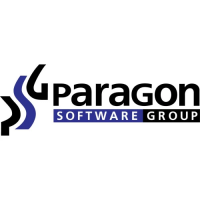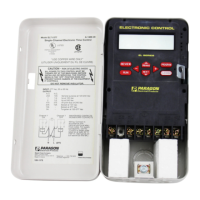Advanced Ramp-Hold
Segments for Controlled Cooling
For controlled cooling,program asegment to alower tem
-
perature than that of the preceding segment.
If you prop the lid for a fast cooling, program a fast rate. If
you program a slow cooling rate, but lower the temperature
quickly by proppingthe lid,the controllerwill defeatyourfast
cooling. It will raise the temperature again.
Forinstance,glassfuserssometimesflash-cooltheglassat
theendoffusing.Theyliftthelidslightlytoremoveheat,then
close the lid again. This takes the glass down rapidly through
the devitrification range. To program a flash-cool, the artist
would program a lower temperature segment with a rate of
9999.
Suppose you enter a cooling rate that is faster than the
kiln’snaturalcoolingrate?Thecontrollerwillwaitforthekiln
to catch up. Then it will continue its controlled cooling. The
controller, of course, cannot speed cooling beyond the kiln’s
natural cooling rate.
CAUTION:During fastcooling,do notopenthe lid
/dooralltheway.Donotforce-coolthekilnwithafan.
Skip Segment
You may need to skip a segment in Ramp-Hold. For in-
stance,youarefiringtocone05forthefirsttime.Youprogram
the last segment to soak for 30 minutes at 1850°F. (This is a
fewdegreesbelowcone05.)Youarenotsureatwhattempera-
ture the cone will bend during this first firing.
At 1850°F, the alarm beeps, alerting you to check the wit-
ness cone on the kiln shelf. You look into the peephole every
few minutes to check the cone. After a 10 minute hold, the
shelf cone 05 bends to maturity. Using “Skip Segment,” the
controller begins a cool-down segment. Skip Segment stops
the current segment and starts the next segment.
Skip Segment works only during firing and only in
Ramp-Hold, not Cone-Fire. To skip a segment, press 9.
SStP will appear. Ifyou change your mindand don’twant to
skipthatsegment, donothingandthefiringwillcontinueas it
was. If you still want to skip the segment, press ENTER. rA
will appear along with the segment number you just skipped
to.
Press 5(“Present Status”) ifyou arenot sure whichseg
-
ment the firing has reached. Then skip the segment.
Sample Firing Schedules
We have included these firing schedules only asexamples.
Each one illustrates a different way to use your DTC 1000.
When designing a firing schedule for materials you are unfa
-
miliar with, or when using one of these schedules, test-fire
samples first. Firing schedule temperatures are shown in °F
for simplicity.
Tofire ceramicsin Ramp-Hold,set thelast firingsegment
to a cone temperature. If you use a temperature in the
Cone-Fire Cone Table, set the last firing segment rate to
108°F/60°C hour. (Cone temperatures in the Cone Table are
based upon a rate of 108°F/60°C during the last 1 - 2 hours.)
Cone-Fire Program Modified in
Ramp-Hold
The following firing schedule is similar to the Medium
Speed Cone-Fire program, fired to cone 04. A slow-cooling
segment was added. (Cone-Fire Medium firing schedule is
shown on page 7.)
Rate Target
Segment Per Hour Temp. Hold
1 110°F 250°F 00.00
2 400°F 1695°F 00.00
3 108°F 1945°F 00.00
4 150°F 1000°F 00.00
Inthisschedule,thekilnwillcoolat150°F/83°Cperhourto
1000°F/537°C. Some ceramists use slow cooling with certain
glazes.
Sculptured Stoneware Bisque
Firing Schedule, Cone 04
This slow firing is for thick stoneware. Change the target
temperature in segment4 whenfiring to adifferent pyromet
-
ric cone. The ware should be bone dry. Test sample pieces.
Leave peephole plugs outand ventthe lid.Set thealarm to
°1000F.Whenthealarmsounds,closethelidfromventingpo-
sition. Set the alarm again, this time to 1850° F. When it
sounds, check the witness cone through the peephole. When
the cone bends to six o’clock, write down the temperature.
(Use that temperaturein segment4 on yournext firingof the
same type of ware.) Then press 9, ENTER (Skip Segment).
Thiswilladvanceyoutosegment5,aslowcoolingsegment.
Donotopentheliduntilthe kilnhas cooledto roomtempera-
ture.
Rate Target
Segment Per Hour Temp. Hold
1 60°F 200°F 03.00
2 80°F 700°F 02.00
3 80°F 1100°F 00.00
4 108°F 1945°F 00.00
5 150°F 1400°F 00.00
Glass Fusing Firing Schedule
(See next page.) Stained glass,
1
8
", 2 layers, full fuse. The
fusing temperaturewill varydepending on the brand ofglass,
and even upon the color. Set the alarm to 500°F. When the
alarm sounds, close the lid from venting position and insert
peepholeplugs.Setthealarmagain,thistimeto1350°F.When
it sounds, check the glass through the peephole. When the
glass fuses to your satisfaction, write down the temperature
and hold time for future firings, and press 9, ENTER (Skip
Segment).
This will advance you to segment 3, a flash cooling seg
-
ment. Lift the kiln lid slightly or open the door ajar until the
temperature drops to 1050° F. Then close the door/lid. The
kilnwillcoolslowlythroughtheannealingrange,thenturnoff.
11

